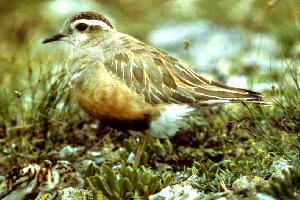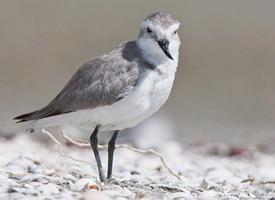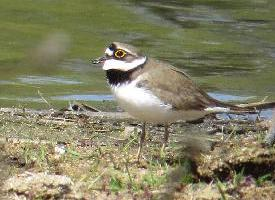
Poids et mesures
| Longueur | de 18 à 20 cm |
|---|---|
| Poids | de 50 à 70 g |
| Envergure des ailes | de 35 à 41 cm |
Description de l'animal
The Common Ringed Plover (Charadrius hiaticula) is a small, distinctive wading bird that is part of the plover family. This bird species is notable for its striking appearance, characterized by its short, stubby bill, relatively plump body, and relatively short legs. The Common Ringed Plover has a wide geographical range, breeding in parts of northern Europe, the Arctic, and in some areas of Asia, with many populations migrating southwards to winter in coastal regions of Africa and southern Europe.Adults typically exhibit a striking color pattern with a black and white face, a white forehead, and a black mask-like band across the eyes. The upperparts are predominantly grey-brown, providing some camouflage against the sandy and rocky habitats they frequent. The chest features a distinctive black band, contrasting sharply with the white belly and undertail. Juveniles and winter adults are generally duller, with the black bands replaced by browner or greyer shades.
One of the most iconic features of the Common Ringed Plover is its bright orange legs and bill, the latter having a black tip. These vibrant colors become more pronounced during the breeding season, making them more visible in their otherwise muted environments.
The Common Ringed Plover prefers habitats that are open and close to water, such as sandy beaches, mudflats, and the shores of lakes and rivers. They are also found in man-made habitats like gravel pits and salt pans. These birds are adept at navigating their environments, using their keen eyesight to spot and pick small invertebrates, such as insects and crustaceans, from the ground.
During the breeding season, the Common Ringed Plover engages in a fascinating courtship display, involving aerial maneuvers, loud calls, and ground displays to attract a mate. They are ground-nesters, with both parents involved in constructing a simple scrape on the ground in which the female lays her eggs. The cryptically colored eggs are well camouflaged against the ground, and both parents share incubation duties to protect them from predators.
The Common Ringed Plover's call is a sharp, clear whistle, often heard in flight or when the birds are alarmed. This call plays an important role in maintaining pair bonds and communicating with offspring.
Despite facing threats from habitat loss and disturbance, particularly in their breeding grounds due to human activity, the Common Ringed Plover has maintained a stable population in many parts of its range. Conservation efforts, including the protection of key breeding and wintering sites, are crucial to ensuring the continued survival of this charming and resilient bird species.
Animaux similaires
Nouvelles photos d'animaux
Top 10 des animaux
- Dolphin gull (Leucophaeus scoresbii)
- Diana monkey (Cercopithecus diana)
- Moustached guenon (Cercopithecus cephus)
- Galápagos tortoise (Geochelone nigra complex)
- Stone loach (Barbatula barbatula)
- Japanese macaque (Macaca fuscata)
- Russian tortoise (Testudo horsfieldii)
- Greek tortoise (Testudo graeca)
- Common flying dragon (Draco volans)
- Vendace (Coregonus albula)


